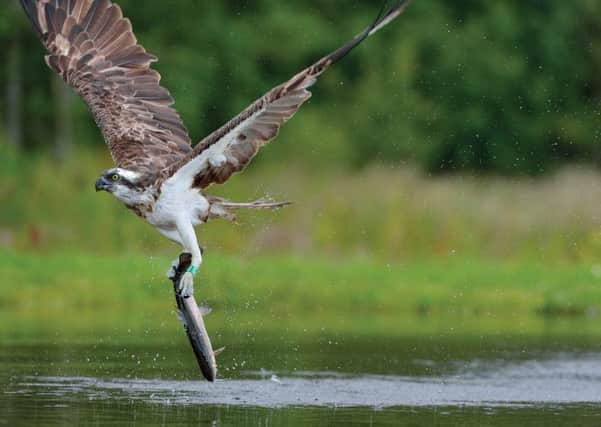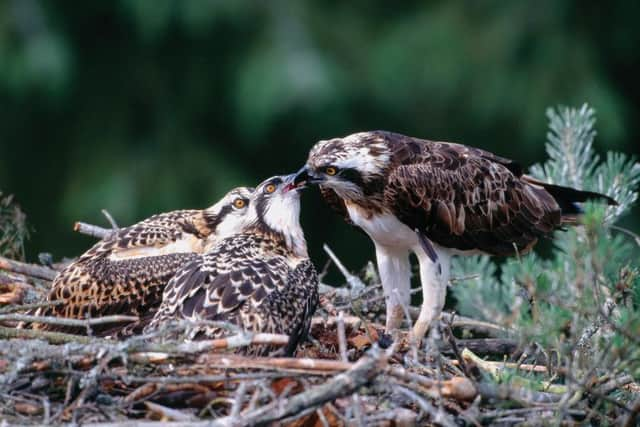Highland ospreys thriving '“ but only thanks to intense efforts


Back in the Spey Valley another bird is coming back to breed, this time all the way from Africa: the osprey. It’s not just any old osprey, but arguably the most famous pair of nesting birds in the world – the celebrated Ospreys of Loch Garten. From soon after the ancestors of these birds first returned here to nest in the 1950s, millions of visitors have tramped through the pine forest to a viewpoint where they watch these birds in all their glory. Today, they can do so from the comfort of a heated visitor centre, decorated with an enormous image of a magnificent osprey, with closed circuit TV screens beaming live, close-up pictures directly from the nest. But it wasn’t always like this. In the early days the few people allowed to sit and watch these birds had to do so from a small, cramped hut, from where dedicated volunteers sat guarding the ospreys around the clock for the whole of the breeding season. They did so because a bird as rare as the osprey inevitably became the target for unscrupulous egg collectors, for whom a clutch of Scottish ospreys’ eggs to add to their collection was the avian equivalent of the Holy Grail. At the time this was the only pair of ospreys nesting anywhere in Britain, the pair that pioneered the birds’ eventual re-establishment as a British breeding species. Ospreys, like most raptor species, had always been persecuted in Scotland, partly because they competed with humans for food – in this case fish – and partly because of sheer prejudice against any bird with a hooked beak and sharp claws. Some species, like the golden eagle, managed to hang on in the face of such persecution; others, like the white-tailed eagle, did not – the last pair of these magnificent birds of prey nested on the Isle of Skye in 1916.
The osprey may or may not have disappeared completely – it is often reported that the last breeding attempt was also in 1916, on Loch Loyne in the Highlands – but raptor expert Roy Dennis believes that a few pairs did manage to hang on and breed during this period in remote parts of the region. Whatever the truth of the matter, when a pair built a nest at Loch Garten in 1954, it was hailed as a momentous event in the world of ornithology. Five years later, in 1959, Operation Osprey began: a scheme to guard the nest against egg collectors, organised with military efficiency by George Waterston (a former prisoner of war and by then the head of the RSPB in Scotland). He also made the controversial (but as it turns out farsighted) decision to invite the public to come to see the nest, working on the assumption that the more people who knew about the ospreys, the safer they would be. Today, well over half a century later, it is clear that Waterston’s scheme didn’t just work; it was a resounding success. Tens of thousands of people come each spring and summer to enjoy watching these charismatic birds. Even though several hundred pairs of ospreys now breed in Scotland, and birds are also nesting in parts of England and Wales, they will no doubt continue to flock to Loch Garten for what Bill Oddie has described as ‘the full osprey experience’. What an experience it is.
Advertisement
Hide AdOspreys are one of the most impressive of all Scotland’s breeding birds. They are also one of the most distinctive, being brown above and creamy-white below, with a distinctive brown stripe through the eye creating a mask-like appearance, a pale crown and a hooked bill. Ospreys are roughly the size of a buzzard, at about 55-60cm (21-24in) long, with a wingspan of up to 180cm (6ft). Ospreys may be rare in Britain, but globally they are both common and widespread, found throughout Europe and much of Asia, North and South America, Africa and Australasia – although the Australian population has just been granted full status as a separate species, now known as the Eastern Osprey.


The male and female breeding here at Loch Garten have spent the six months or so since they left the Highlands apart. The male arrived back first, in late March, having travelled almost 5,000km (3,000 miles) from his winter quarters along the coasts of West Africa. We now know far more about these osprey movements each spring and autumn, as several birds have been fitted with radio-tracking devices, which give regular and precise indications of exactly where they are.
A week later the female joined him, and they began renewing their pair bond, the male performing his famous aerial display above the forest. Soon afterwards, in mid-April, the female laid first one egg, then a second, and started to incubate. For the next five weeks or so she sat tight, being brought fish by her mate, who occasionally took his turn on the nest to allow her to stretch her wings and hunt for herself. She may fish in the waters of nearby Loch Garten, only a short distance from her nest, but more often than not she heads a few miles further, to the fish farm at Inverdruie. With large pools well stocked with thousands of rainbow trout, this is the equivalent of a free buffet lunch for the ospreys. They approach over the trees, drop down towards the water and simply grab their unsuspecting prey with their sharp, pointed talons. Ospreys have a specially adapted, reversible outer toe. This enables them to hold their catch with two toes pointing forwards and two behind, which gives them an excellent grip on slippery fish such as trout and salmon. The only other birds that share this feature are, strangely, owls. Ospreys used to be ruthlessly persecuted for taking fish, but in these more enlightened times the owners of the fish farm have embraced the birds’ presence, knowing that it attracts many visitors, especially bird photographers, who pay good money for the chance to get a spectacular shot of a fishing osprey. Thus what might have been an economic problem has been turned into a benefit for their business. Back at the nest, by mid-May the chicks have safely hatched, and throughout the rest of May and June they grow bigger and bigger on the trout and salmon brought back by their parents. At first they are scruffy little things, but gradually they begin to resemble the adults. After eight or nine weeks they stand up in the nest and flap their wings, in preparation for the day when they must launch themselves off the edge of this platform of sticks and into the unknown. n
• Highlands: Scotland’s Wild Heart continues on Wednesdays, BBC1 at 9pm. The accompanying book by Stephen Moss with photographs by Laurie Campbell is out now, published by Bloomsbury, £25